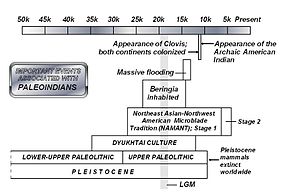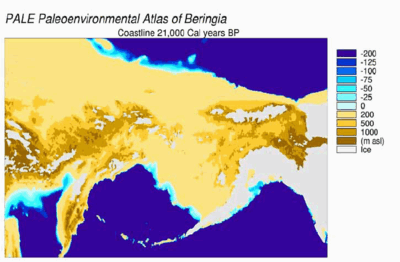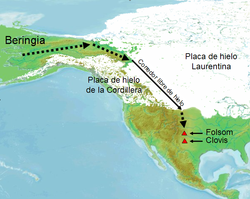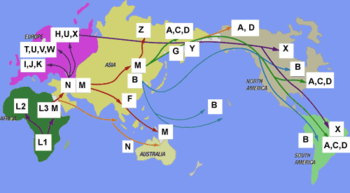- Origins of Paleoindians
-
See also: Models of migration to the New World
Paleoindians refers to the ancestral peoples of modern Indigenous peoples of the Americas. They are thought to have populated North America and South America around the end of the last ice age. Their exact origins and the route and timing of their migrations are the subject of much discussion.
Contents
The Land Bridge
Further information: Beringia and Models of migration to the New WorldThe Last Glacial Maximum (LGM) of the Wurm/Wisconsin glacial period occurred approximately 20,000-18,000 years ago. Extremely cold weather resulted in the formation of vast ice sheets across the Earth's northernmost and southernmost latitudes. Glaciers also formed south of the 30th parallel in the Andean Mountains along the western coast of South America. As the ice sheets formed, sea levels dropped worldwide. When the Bering and Chukchi Seas had dropped some 400 feet lower than their present level, land beneath the Bering Strait was exposed. This is referred to as Beringia, an ancient Ice Age subcontinent that united the eastern and western hemispheres [1 140; 2 60].
The Bering land bridge was a treeless, grassy tundra over 1000 miles wide. Broad temperature fluctuations produced below-freezing nighttime conditions. Permafrost kept the soil frozen year round except in the summer, when the first few inches of topsoil became waterlogged and spongy.
Several groups from Asia migrated across Beringia to enter and populate North America. The standard model includes Eurasian big-game hunters travelling across Siberia to Beringia. Other models include Southeast Asians using watercraft to skip along the Pacific Rim, arriving in the Americas via a coastal route.
After 18,000 years ago, the world began to warm up and the ice sheets began to melt, causing sea levels to rise. Massive flooding occurred from 15,000 to 13,000 years ago, when ice dams high in the mountains were breached. By 14,000 years ago, the land bridge lay submerged beneath the Bering Strait [3 199, 206; 4 1; 5].
The Paleoindians
Main article: Paleo-IndiansThe Wisconsin ice sheet that covered Canada was almost 2 miles thick and blocked any movement through the interior by Paleo-Arctic dwellers. By 12,000, it had broken up into two smaller ice sheets—the Cordilleran and the Laurentide. This formed the McKenzie corridor--an ice-free passage from Alaska to the Montana-North Dakota border. Paleo-Arctic populations that remained on the Arctic coast were generally more adept at hunting sea mammals and fishing than those who pursued caribou, mammoths, and other terrestrial mammals into the interior once the McKenzie corridor opened [2 60, 62; 3 206].
- "Paleoindians are thought to have lived primarily as small, mobile groups of big game hunters." [9 129]
Paleoindians travelled light and moved frequently—they were always moving to find new sources of plant foods and wild game. They did not carry much food and their tool kit of microblades was easily transported. Their diet was often sustaining and rich in protein due to successful hunting.
A highly mobile people such as the Paleoindians, probably had a surprisingly high reproductive rate. Travelling light during frequent moves was a more efficient utilization of calories than hunting and foraging further and further away from more permanent encampments. Paleoindians could carry more and provide for more children on the move than if they had built permanent settlements. In the bottleneck of Middle America, their birth rate decreased when "new" hunting grounds were found already populated by other bands. This slowed their progress and allowed the higher costs of more permanent residence to accumulate [10 501-504].
The Paleoindians may have moved every 3–4 days and covered 150 to 200 miles a year [10 501-502]. A thin population of humans spread over both Americas by 11,000 when the Clovis culture appeared in the Southwest. Paleoindians are generally associated with Clovis spearpoints that were hafted to darts and hurled from atlatls at the last mammoths on earth. Clovis culture was gone in 300 years but the stage had been set for the appearance of the earliest American Archaic Indians [3 205, 210].
The Paleo-Arctic
Main article: Paleo-Arctic TraditionThe manufacture of microliths and composite tools from 27,000-7,000 is known as the Northeast Asian-Northwest American Microblade Tradition (NAMANT) or the Paleo-Arctic tradition. This was the first stage in colonization of the Arctic and included both continents. The Paleo-Arctic tradition contained elements from both southeast Asian boat-building and northeast Asian microblade technologies.
The Paleo-Arctic tradition diffused into North America no later than 14,000 when early inhabitants of the Aleutian Islands began to exploit the coast for fish and sea mammals. Paleo-Arctic (or Stage 1) sites include Anangula (>7,000) on Umnak Island in the Aleutian islands chain, Onion Portage (15,000), and Old Crow Flats (29,000) in the Yukon just east of the Alaskan border [6 34, 45-46].
The Asian Paleo-Arctic tradition would eventually give rise to the modern maritime hunting and gathering cultures of the Koryak, Tungas, Chukchee, and Siberian Inuit. The American Paleo-Arctic tradition appears to have included at least two groups—the Aleuts and Inuit of the Arctic and the ancestors of Paleoindians.
The Aleuts and Inuit
One group adapted to the rich resources that could be harvested from the sea. These Upper Stone Age hunters set microblades into grooves on bone points, hafted them onto various types of shafts, and used them to hunt seals, whales, and caribou [3 195-196; 6 34, 45-46]. They were probably the first people on earth to build watercraft by covering wooden frames with sealskins.
The Paleolithic ended by 10,000 and, in the New World, was followed by the Middle Lithic. By the end of the Middle Lithic in 7,000, small isolated settlements had appeared on the Aleutian Islands, the Alaskan Peninsula, and on both sides of the Seward Peninsula. After 4,500, continued melting of the polar ice cap opened the Arctic waters and permitted widespread settlement along the Arctic ring from Alaska to Greenland. This culture of Arctic dwellers would eventually become the Aleuts and Inuit—modern hunters and fishers of the Arctic [6 43-44, 46].
Paleoindian Genes
Further information: Genetic history of indigenous peoples of the AmericasThe gene pool of Paleoindians (and today's Native Americans) may have also received contributions from ancestors of the present-day Ainu. The Ainu are an ancient culture of hunters, gatherers, and farmers who still live on the Japanese island of Hokkaidō and the Kurile Islands in the archipelago north of Japan. A small population of Ainu still survive. They possess features of both Japanese and the European Caucasoid: light complexions, wavy hair, and sturdy bodies [7 54].
In addition to the Ainu, other present-day hunter-gatherer societies that have remained isolated in northeast Asia and North America and whose ancestors may have contributed to the gene pool of Paleoindian are the Yukaghir, Inuit, Aleut, Koniag, Kamchadal, Chukchi, and Koryak. However, in one anthropological study, only three groups of Gm allotypes (i.e. special blood proteins) were found in Native Americans. One group is supposedly that of the Paleoindians (which also includes thousands of Central and South American Indians) and the second is that of the Inuit and Aleuts. Another study involving mitochondrial DNA suggests a single founding tribe diverged into 4 specific mtDNA lineages responsible for 95% of all Amerindian genotypes. These 4 lineages may have roots in present-day Siberian, Mongolian, and Tibetan populations. A fifth lineage known as Haplogroup X (mtDNA) has been associated with European or Eurasian populations [3 204; 11 226-227; 10 56-58].
The most telling physical evidence for the ancestry of the first Americans is a unique "shovelling" of the two central upper incisors. The posterior surface of the teeth is hollowed like a shovel and referred to as sinodonty. Sinodonty is common amongst populations of Native Americans in North, Central, and South America; and in Turkestan (from the Caspian Sea to the Gobi Desert), Southeast Asia, the Pacific Islands, and Siberia. A population of Sami from Finland are also classified as sinodonts.
Opposed to sinodonty, sundadonty is found from Africa to Central Asia and Scandinavia. Most, but not all[1] prehistoric North and South American human remains display a common Asian ancestry, including the skulls found in Minnesota which are dated to about 8,500 years. The well-known Kennewick Man remains are thought to exhibit sundadonty. [3 196-198, 233, 236; 7 53, 55].
See also
- Pre-Columbian trans-oceanic contact
- Lithic stage in Canada (18000 BCE - 8000 BCE)
- Haplogroup X (mtDNA)
- Kennewick Man
- Solutrean hypothesis
Bibliography
- Gowlett, John. Ascent To Civilization. New York: Alfred A. Knopf, 1984.
- Petit, Charles W. "Rediscovering America." U. S. News & World Report, October 12, 1998.
- Fagan, Brian M. The Journey from Eden. London: Thames and Hudson, 1990.
- Gilsen, Leland. "Pleistocene Adaptations." May 29, 1999. Oregon Archaeology: Prehistory. June 2, 2000 [1].
- Beringia Research. Yukon Beringia Interpretative Centre. Dec. 7, 2000 [2].
- Coe, Michael, Dean Snow, and Elizabeth Benson. Atlas of Ancient America. New York: Facts On File Publications, 1986.
- Begley. Sharon and Andrew Murr. "The First Americans." Newsweek, April 26, 1999.
- Roosevelt, A. C. et al. "Paleoindian Cave Dwellers in the Amazon: The Peopling of the Americas." Science, April 19, 1996.
- Price, Douglas and Gary Feinmen, editors. "Monte Verde Early Hunter-Gatherers in South America." Images of the Past. 1997.
- Surovell, Todd A. "Early Paleoindian Women, Children, Mobility, and Fertility." American Antiquity, 65 (3), 2000.
References
- ^ Neves, W. A.; Powell, J. F.; Prous, A.; Ozolins, E. G.; Blum, M. (1999). "Lapa vermelha IV Hominid 1: morphological affinities of the earliest known American". Genetics and Molecular Biology 22 (4). doi:10.1590/S1415-47571999000400001.
 Indigenous peoples of the Americas
Indigenous peoples of the AmericasHistory 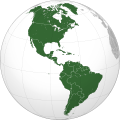
European
colonizationBy country North AmericaGreenland · Canada · United States · Jamaica · Mexico · Central America · El Salvador · West Indies · PanamaSouth AmericaRelated topics Indigenous American studies · Indigenous languages · Indigenous Movements · Indigenous art · Artists · WritersCategory · Portal Categories:- Paleoindian period
- Pleistocene
- History of indigenous peoples of the Americas
- History of indigenous peoples of North America
- History of the Americas
- History of North America
- History of South America
- Origin hypotheses of ethnic groups
Wikimedia Foundation. 2010.

